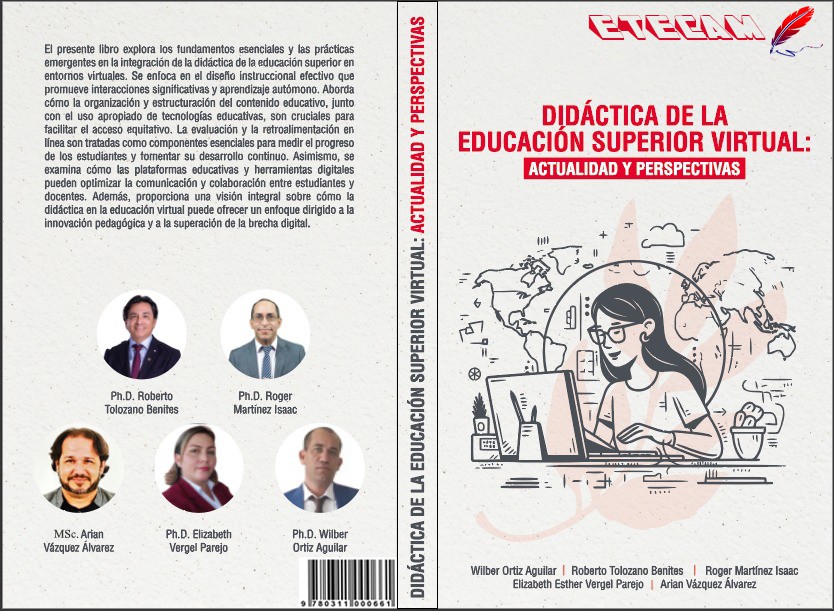Didáctica de la educación superior virtual: actualidad y perspectivas
ISBN: 978-0-3110-0066-1; BIC: YQS
DOI:
https://doi.org/10.51736/eta.vi.91Palabras clave:
educación virtual, educación en línea, tecnología, enseñanza superiorResumen
El presente libro explora los fundamentos esenciales y las prácticas emergentes en la integración de la didáctica de la educación superior en entornos virtuales. Se enfoca en el diseño instruccional efectivo que promueve interacciones significativas y aprendizaje autónomo. Aborda cómo la organización y estructuración del contenido educativo, junto con el uso apropiado de tecnologías educativas, son cruciales para facilitar el acceso equitativo. La evaluación y la retroalimentación en línea son tratadas como componentes esenciales para medir el progreso de los estudiantes y fomentar su desarrollo continuo. Asimismo, se examina cómo las plataformas educativas y herramientas digitales pueden optimizar la comunicación y colaboración entre estudiantes y docentes. Además, proporciona una visión integral sobre cómo la didáctica en la educación virtual puede ofrecer un enfoque dirigido a la innovación pedagógica y a la superación de la brecha digital.
Descargas
Citas
Adib, A., Zaerpour, A., & Lotfirad, M. (2021). On the reliability of a novel MODWT-based hybrid ARIMA-artificial intelligence approach to forecast daily snow depth (Case study: The western part of the rocky mountains in the U.S.A). Cold Regions Science and Technology, 189, Article 103342. https://doi.org/10.1016/j.coldregions.2021.103342
Aguayo, R., Lizarraga, C., & Quiñonez, Y. (2021). Evaluación del desempeño académico en entornos virtuales utilizando el modelo PNL. Revista Ibérica de Sistemas e Tecnologias de Informação, 2021(41), 34-49.
Alatorre Rojo, E. P. (2019). La evaluación entre pares: Una estrategia de enseñanza aprendizaje en línea. En D. Montes Ponce & M. A. Pereira Alfaro (Eds.), Estrategias didácticas digitales (pp. 34-52). https://issuu.com/uajournals/docs/000003
Ally, M. (2008). Foundations of Educational Theory for Online Learning. In T. Anderson (Ed.), The Theory and Practice of Online Learning (2nd ed., pp. 15-44). Athabasca University Press.
Alvarado, L. F. V., & Macias, J. F. V. (2023). Tecnologías emergentes aplicadas a la educación. Dominio de las ciencias, 9(4), 668-780.
Álvarez, O. M. H. F., & Carrillo, F. H. (2020). Creación de ambientes de aprendizaje colaborativo en aulas virtuales. Eutopía, 12(33), 15-24.
Amann, B. (2016). Educación para el desarrollo sostenible (EDS) y arquitectura escolar. Bordón. Revista de Pedagogía, 68(1), 145-163. https://doi.org/10.13042/Bordon.2016.68109
Anderson, T. (2008). The Theory and Practice of Online Learning. AU Press.
Aparicio, D. M. S., Peñafiel, E. S. P., Yagual, E. A. D. R., & Aparicio, P. R. S. (2021). Multimedia e hipermedia aplicada en la educación. RECIAMUC, 5(2), 70-78.
Apodaca-Orozco, G. U., Ortega-Pipper, L. P., Verdugo Blanco, L. E., & Reyes-Barribas, L. E. (2017). Modelos educativos: un reto para la educación en salud. Ra Ximhai, 13(2), 77-86. http://www.redalyc.org/articulo.oa?id=46154510006
Araujo, J., Betancourt, J., Gómez Ar-goti, J. del S., González, F. J., & Pareja, M. T. (2015). La pedagogía crítica el verdadero camino hacia la transformación social. Tesis (Maestría en Educación desde la Diversidad), Universidad de Manizales. Recuperado de https://ridum.umanizales.edu.co/xmlui/handle/20.500.12746/2230
Arnaiz, N. V. Q., Arias, N. G., & Galarza, F. P. C. (2022). La utilización de herramientas de comunicación sincrónica y asincrónica para la enseñanza y aprendizaje en las universidades del Ecuador. Revista Conrado, 18(S2), 509-517.
Arroyo, Z., Fernández, M., Barreto, L., & Paz, L. (2018). Entornos virtuales de aprendizaje en comunidades de práctica de docentes universitarios del Ecuador. Ensayos pedagógicos, 13(2), 185-200. http://dx.doi.org/10.15359/rep.13-2.9
Aurioles, M. E. W. (2021). Diez herramientas digitales para facilitar la evaluación formativa. Revista Tecnología, Ciencia y Educación, (18), 127-139.
Azzolini, D., Marzadro, S., Rettore, E., Engelhardt, K., Hertz, B., & Wastiau, P. (2023). Raising teacher retention in online courses through personalized support. Evidence from a cross-national randomized controlled trial. Journal of Research on Educational Effectiveness, 16(2), 300-325. https://doi.org/10.1080/19345747.2022.2100850
Barberá-Gregori, E., & Suárez-Guerrero, C. (2021). Evaluación de la educación digital y digitalización de la evaluación. RIED. Revista Iberoamericana de Educación a Distancia, 24(2), 33-40. https://doi.org/10.5944/ried.24.2.30289
Bates, A. W., & Sangrà, A. (2011). Managing Technology in Higher Education: Strategies for Transforming Teaching and Learning. Jossey-Bass.
Bates, A. W. (2015). Teaching in a digital age: Guidelines for designing teaching and learning. BCcampus.
Bawa, P. (2016). The importance of studying retention issues in online courses retention in online courses: Exploring issues and solutions-a literature review. Newbury Park, CA, USA: Sage.
Benabdelouahab, S., García-Berná, J. A., Moumouh, C., Carrillo-de-Gea, J. M., El Bouhdidi, J., El Younoussi, Y., & Fernández-Alemán, J. L. (2023). A Bibliometric Study on E-Learning Software Engineering Education. Journal of Universal Computer Science, 29(6), 510.
Benvenuto, D., Giovanetti, M., Vassallo, L., Angeletti, S., & Ciccozzi, M. (2020). Application of the ARIMA model on the COVID-2019 epidemic dataset. Data in Brief, 29, Article 105340. https://doi.org/10.1016/j.dib.2020.105340
Black, P., & Wiliam, D. (1998). Assessment and Classroom Learning. Assessment in Education. Principles, Policy & Practice, 5(1), 7-74.
Bolliger, D. U., & Halupa, C. (2012). Student perceptions of satisfaction and anxiety in an online doctoral program. Distance Education, 33(1), 81-98.
Blumenfeld, P. C., Soloway, E., Marx, R. W., Krajcik, J. S., Guzdial, M., & Palincsar, A. (1991). Motivating project-based learning: Sustaining the doing, supporting the learning. Educational Psychologist, 26(3-4), 369-398. https://doi.org/10.1207/s15326985ep2603&4_8
Branch, R. M. (2009). Instructional Design: The ADDIE Approach. Springer Science & Business Media.
Bron, M. (2019). Comunicación transmedia y educación: el aprendizaje basado en proyectos colaborativos como método de aprendizaje en comunicación digital (Doctoral dissertation, Universidad Rey Juan Carlos).
Brown, J. S., & Lippincott, J. K. (2003). Learning Spaces: More than Meets the Eye. EDUCAUSE Review, 38(6), 14-26.
Brown, G. T. L., & Hirschfeld, G. H. F. (2017). Students' conceptions of assessment: Links to outcomes. Assessment & Evaluation in Higher Education, 42(1), 48-64.
Burgstahler, S. (2015). Opening doors or slamming them shut? Online learning practices and students with disabilities. Social Inclusion, 3(6), 69-79.
Burgstahler, S. (2015). Universal Design in Higher Education: From Principles to Practice. Harvard Education Press.
Cabero, J., & Palacios, A. (2021). La evaluación de la educación virtual: las e-actividades. La evaluación de la educación virtual: las e-actividades, 24 (2), 169-188. https://doi.org/10.5944/ried.24.2.28994
Cangalaya, L. M. (2020). Habilidades del pensamiento crítico en estudiantes universitarios a través de la investigación. Desde el sur, 12(1), 141-153.
Cárdenas, F., & Luna, J. (2020). Evaluación en línea ante la pandemia por Covid-19: retos y oportunidades para las universidades mexicanas. Revista Universidad y Sociedad, 12(6), 394-403. https://rus.ucf.edu.cu/index.php/rus/article/view/1860
Cardona, A., Velez-Ramos, J., & Jaramillo, S. (2018). Metodología para la evaluación de competencias en un entorno de aprendizaje virtual. Revista Espacios, 39(23). https://www.revistaespacios.com/a18v39n23/18392303.html
Carless, D., & Boud, D. (2018). The Development of Student Feedback Literacy: Enabling Uptake of Feedback. Assessment & Evaluation in Higher Education, 43(8), 1315-1325. doi: 10.1080/02602938.2018.1463354
Carrión, C. R. N., & Carrera, M. Á. V. (2021). Percepción estudiantil de la importancia de la retroalimentación. Revista Vínculos ESPE, 6(2), 45-55.
Castillo, É. Y., García, N. N., Corredor, C. M., & Malaver, C. E. C. (2017). Evolución de la educación superior a distancia: desafíos y oportunidades para su gestión. Revista Virtual Universidad Católica del Norte, (50), 81-105.
Castro, M., & Hernández, R. (2020). TIC y educación: La brecha digital. Educación y futuro digital, 12-34.
Chiu, C. M., & Wang, E. T. (2008). Understanding Web-based learning continuance intention: The role of subjective task value. Information & management, 45(3), 194-201.
Choque, C. A. M., Alzamora, K. P. G., Cáceres, N. A., Bedoya, N. M. G., & Mamani, M. T. (2022). Retroalimentación Según los Efectos en el Aprendizaje en la Educación Virtual. Educateconciencia, 30(34), 241-265.
Crisol Moya, E., Herrera Nieves, L. B., & Montes Soldado, R. (2020). Educación virtual para todos: una revisión sistemática. Education in the knowledge society: EKS.
Croxton, R. A. (2014). The role of interactivity in student satisfaction and persistence in online learning. Journal of Online Learning and Teaching, 10(2), 314-325.
Daghestani, L. F., Ibrahim, L. F., Al-Towirgi, R. S., & Salman, H. A. (2020). Adapting gamified learning systems using educational data mining techniques. Computer Applications in Engineering Education, 28(3), 568–589. https://doi.org/10.1002/cae.22227
Deci, E. L., & Ryan, R. M. (2000). The” what” and” why” of goal pursuits: Human needs and the self-determination of behavior. Psychological inquiry, 11(4), 227-268.
Deci, E. L., Vallerand, R. J., Pelletier, L. G., & Ryan, R. M. (1991). Motivation and education: The self-determination perspective. Educational psychologist, 26(3-4), 325-346.
Dell, C. A., Dell, T. F., & Blackwell, T. L. (2015). Applying universal design for learning in online courses: Pedagogical and practical considerations. Journal of Educators Online, 12(2), 166-192.
Dennen, V. P. (2008). Digital collaboration: Foundation for blended learning in higher education. British Journal of Educational Technology, 39(5), 828-837. doi: 10.1111/j.1467-8535.2007.00791.x
Deterding, S., Dixon, D., Khaled, R., & Nacke, L. (2011). From game design elements to gamefulness: Defining “gamification”. In Proceedings of the 15th International Academic MindTrek Conference: Envisioning Future Media Environments (pp. 9-15). ACM. https://doi.org/10.1145/2181037.2181040
Dick, W., Carey, L., & Carey, J. O. (2005). The systematic design of instruction. Pearson.
Dorrego, E. (2016). Educación a distancia y evaluación del aprendizaje. Revista de Educación a Distancia (RED), (50). http://dx.doi.org/10.6018/red/50/12
Dunleavy, M., Dede, C., & Mitchell, R. (2009). Affordances and limitations of immersive participatory augmented reality simulations for teaching and learning. Journal of Science Education and Technology, 18(1), 7-22. https://doi.org/10.1007/s10956-008-9119-1
Durán, R., Estay-Niculcar, C., & Álvarez, H. (2015). Adopción de buenas prácticas en la educación virtual en la educación superior. Aula abierta, 43(2), 77-86.
Dyckhoff, A. L., Zielke, D., Bültmann, M., Chatti, M. A., & Schroeder, U. (2012). Design and implementation of a learning analytics toolkit for teachers. Educational Technology & Society, 15(3), 58-76.
Elhossiny, M., Eladly, R., & Saber, A. (2022). The integration of psychology and artificial intelligence in e-learning systems to guide the learning path according to the learner’s style and thinking. International Journal of Advanced Applied Sciences, 9(12), 162-169. https://doi.org/10.21833/ijaas.2022.12.020
Fernández, A. (2019). Evaluando la evaluación de los aprendizajes. UFG-Editores. http://ri.ufg.edu.sv/jspui/bitstream/11592/9711/1/Evaluando%20la%20evaluacion%20de%20los%20aprendizajes.pdf
Ferrario, A., Loi, M., & Viganò, E. (2020). In AI we trust incrementally: A multi-layer model of trust to analyze human-artificial intelligence interactions. Philosophy & Technology, 33(3), 523–539. https://doi.org/10.1007/s13347-019-00378-3
Fuentes, A., Pastora, B., Granados, A., & Puerto, O. (2021). El proceso de evaluación del aprendizaje desde el Entorno Virtual de Aprendizaje en el nivel universitario. Revista Científica UISRAEL, 8(3), 117-134. https://doi.org/10.35290/rcui.v8n3.2021.345
Gagné, R. M., Wager, W. W., Golas, K. C., & Keller, J. M. (2005). Principles of Instructional Design. Wadsworth/Thomson Learning.
Gallego, M.J., Gámiz, V., Gutiérrez, E. (2015). Tendencias en la evaluación del aprendizaje en cursos en línea masivos y abiertos. Educación XX1, 18(2): 77-96. http://hdl.handle.net/10481/37255
Gamboa, A. R., Builes, J. J., & Duran, D. E. S. (2016). Personalización de contenidos en t-learning a través de Universal Design for Learning (UDL). no. September, 10-15.
García, I., Trujillo, X., Domínguez, J., & Navas, W. (2021). API para control de asistencia con reconocimiento facial usando OpenCv. JS. Revista Tecnológica Ciencia y Educación Edwards Deming, 5(1). https://www.revista-edwardsdeming.com/index.php/es/article/view/67
Garrido, M. C., et al. (2021). Innovación docente y uso de metodologías activas y recursos innovadores en la universidad: estado de la cuestión. Revista Española de Pedagogía, 79(279), 251-270.
Garrido, A., Morales, L., & Serina, I. (2016). On the use of case-based planning for e-learning personalization. Expert Systems with Applications, 60, 1-15.
Garrison, D. R., & Cleveland-Innes, M. (2005). Facilitating cognitive presence in online learning: Interaction is not enough. American Journal of Distance Education, 19(3), 133-148.
Garrison, D. R., & Cleveland-Innes, M. (2005). Facilitating cognitive presence in online learning: Interaction is not enough. American Journal of Distance Education, 19(3), 133-148.
Garrison, D. R., & Vaughan, N. D. (2008). Blended Learning in Higher Education: Framework, Principles, and Guidelines. Jossey-Bass.
Garrison, D. R., & Cleveland-Innes, M. (2005). Facilitating cognitive presence in online learning: Interaction is not enough. American Journal of Distance Education, 19(3), 133-148.
Gazzawe, F., Mayouf, M., Lock, R., & Alturki, R. (2022). The role of machine learning in E-learning using the web and AI-enabled mobile applications. Mobile Information Systems, 2022, 1-10. https://doi.org/10.1155/2022/3696140
Gibson, D. C., & Ifenthaler, D. (2010). Development and Validation of a Technology-Based Learning Environment Instrument. British Journal of Educational Technology, 41(2), 227-241.
Gikas, J., & Grant, M. M. (2013). Mobile computing devices in higher education: Student perspectives on learning with cellphones, smartphones & social media. Internet and Higher Education, 19, 18-26. https://doi.org/10.1016/j.iheduc.2013.06.002
Gikandi, J. W., Morrow, D., & Davis, N. E. (2011). Online formative assessment in higher education: A review of the literature. Computers & Education, 57(4), 2333-2351.
Gómez-Gómez, M., (2023). La innovación y la tecnología como elementos claves en el contexto de educación superior. Revista Virtual Universidad Católica del Norte, (69), 1-6. https://doi.org/10.35575/rvucn.n69a1
Grant, M., Wilkins, S., & Houghton, L. (2020). The role of inclusivity and diversity in fostering student engagement. Higher Education Research & Development, 39(7), 1297-1311. https://doi.org/10.1080/07294360.2020.1768157
Gros, B. (2016). The design of smart educational environments. Smart learning environments, 3, 1-11.
Guo, P. J., Kim, J., & Rubin, R. (2014). How video production affects student engagement: An empirical study of MOOC videos. In Proceedings of the First ACM Conference on Learning @ Scale (pp. 41-50).
Hamari, J., Koivisto, J., & Sarsa, H. (2014). Does gamification work? -- A literature review of empirical studies on gamification. In 2014 47th Hawaii International Conference on System Sciences (pp. 3025-3034). IEEE. https://doi.org/10.1109/HICSS.2014.377
Harasim, L. (2017). Learning theory and online technologies. Routledge.
Hattie, J., & Timperley, H. (2007). The power of feedback. Review of educational research, 77(1), 81-112.
Huang, R., Spector, J. M., & Yang, J. (2020). Educational Technology: A Primer for the 21st Century. Springer.
Heffernan, N. T., & Heffernan, C. L. (2014). The ASSISTments ecosystem: Building a platform that brings scientists and teachers together for minimally invasive research on human learning and teaching. International Journal of Artificial Intelligence in Education, 24, 470-497.
Herrington, J., Reeves, T. C., & Oliver, R. (2014). Authentic learning environments. In J. M. Spector, M. D. Merrill, J. Elen, & M. J. Bishop (Eds.), Handbook of Research on Educational Communications and Technology (4th ed., pp. 401-412). Springer.
Hessen, S. H., Abdul-kader, H. M., Khedr, A. E., & Salem, R. K. (2022). Developing multiagent E-learning system-based machine learning and feature selection techniques. Computational Intelligence and Neuroscience, 2022, 1-8. https://doi.org/10.1155/2022/2941840
Hidalgo, N., & Torrecilla, F. (2017). Las concepciones sobre el proceso de evaluación del aprendizaje de los estudiantes. REICE: Revista Iberoamericana sobre Calidad, Eficacia y Cambio en Educación, 15(1), 107-128. http://dx.doi.org/10.15366/reice2017.15.1.007
Hildebrand, L. A., Pierce, C. J., Dennis, M., Paracha, M., & Maoz, A. (2021). Artificial intelligence for histology-based detection of microsatellite instability and prediction of response to immunotherapy in colorectal cancer. Cancers, 13(3), 391. https://doi.org/10.3390/cancers13030391
Jonassen, D. H. (2011). Learning to solve problems: An instructional design guide. John Wiley & Sons.
Kebritchi, M., Lipschuetz, A., & Santiague, L. (2017). Issues and challenges for teaching successful online courses in higher education: A literature review. Journal of Educational Technology Systems, 46(1), 4-29. https://doi.org/10.1177/0047239516661713
Keller, J. M. (1987). Development and Use of the ARCS Model of Motivational Design. Journal of Instructional Development, 10(3), 2-10.
Keller, J. M. (2010). Motivational design for learning and performance: The ARCS model approach. Springer Science & Business Media.
Kember, D., Jones, A., Loke, A. Y., McKay, J., Sinclair, K., & Tse, H. (2008). Determining the Level of Reflectivity in Students: Development of a Questionnaire and Its Validity in Accounting Education. Assessment & Evaluation in Higher Education, 33(5), 507-519. doi: 10.1080/02602930701773018
Kim, K., & Lee, H. (2019). The impact of counseling support on online students' course participation and academic performance. Internet and Higher Education, 40, 50-60. https://doi.org/10.1016/j.iheduc.2019.100706
Lezcano, L., & Vilanova, G. (2017). Instrumentos de evaluación de aprendizaje en entornos virtuales. Perspectiva de estudiantes y aportes de docentes. Informes Científicos Técnicos-UNPA, 9(1), 1-36. https://doi.org/10.22305/ict-unpa.v9i1.235
Lima S., & Fernández, F. A. (2017). La educación a distancia en entornos virtuales de enseñanza aprendizaje. Revista Tecnología Educativa, 1(1) https://tecedu.uho.edu.cu/index.php/tecedu/article/view/14
Lindgren, R., & Johnson-Glenberg, M. C. (2013). Emboldened by embodiment: Six precepts for research on embodied learning and mixed reality. Educational Researcher, 42(8), 445-452.
Liu, Q., Peng, W., Zhang, F., Hu, R., Li, Y., & Yan, W. (2019). The Effectiveness of Blended Learning in Health Professions: Systematic Review and Meta-Analysis. Journal of Medical Internet Research, 21(1), e12925. doi: 10.2196/12925
Livingstone, S., Ólafsson, K., Helsper, E. J., Lupiáñez-Villanueva, F., Veltri, G. A., & Folkvord, F. (2017). Maximizing opportunities and minimizing risks for children online: The role of digital skills in emerging strategies of parental mediation. Journal of communication, 67(1), 82-105.
Locke, E. A., & Latham, G. P. (2002). Building a practically useful theory of goal setting and task motivation: A 35-year odyssey. American Psychologist, 57(9), 705-717.
Lowenthal, P. R., & Dunlap, J. C. (2018). Investigating students’ perceptions of flexibility in online courses. The International Review of Research in Open and Distributed Learning, 19(2), 172-191. https://doi.org/10.19173/irrodl.v19i2.3381
Luis, J. R., Alcocer, A. C., & Barrio, M. G. (2020). El video artículo multimedia interactivo, un formato innovador para la comunicación científica. ASRI: Arte y sociedad. Revista de investigación, (18), 90-110.
Lynch, R. (2017). Learning analytics: Challenges and limitations. In Educational Data Mining: Applications and Trends (pp. 113-132). Springer.
Mansilla, D. A. (2022). El rol de las estrategias socioafectivas en la enseñanza y el aprendizaje colaborativo y situado de la traducción en una clase virtual (Doctoral dissertation, Universitat Ramon Llull).
Margaryan, A., Bianco, M., & Littlejohn, A. (2015). Instructional quality of massive open online courses (MOOCs). Computers & Education, 80, 77-83.
Mateos, J. G., Martínez, A. G., & Atiaja, N. A. (2021). El diseño instruccional: ruta necesaria en la educación virtual: Instructional design: a necessary path into virtual education. Revista Científica Ecociencia, 8, 65-78.
Mayer, R. E. (2019). How multimedia can improve learning and instruction. Impact (2514-6955).
Mazur, E. (2009). Farewell, Lecture? Science, 323(5910), 50-51. doi:10.1126/science.1168927
Means, B., Toyama, Y., Murphy, R., Bakia, M., & Jones, K. (2010). Evaluation of Evidence-Based Practices in Online Learning: A Meta-Analysis and Review of Online Learning Studies. U.S. Department of Education. https://www2.ed.gov/rschstat/eval/tech/evidence-based-practices/finalreport.pdf
Mellado-Moreno, P. C., Sánchez-Antolín, P., & Blanco-García, M. (2021). Tendencias de la evaluación formativa y sumativa del alumnado en Web of Sciences. Alteridad. Revista de Educación, 16(2), 170-183.
Meyer, K. A. (2004). Evaluating online discussions: Four different frames of analysis. Journal of Asynchronous Learning Networks, 8(2), 101-114.
Merrill, M. D. (2002). First Principles of Instruction. Educational Technology Research and Development, 50(3), 43-59.
Mishra, P., & Koehler, M. J. (2006). Technological Pedagogical Content Knowledge: A Framework for Teacher Knowledge. Teachers College Record, 108(6), 1017-1054.
Mor, Y., & Craft, B. (2012). Learning design: reflections upon the current landscape. Research in learning technology, 20.
Morales, G. E., López, R. M., García, Á., & López, E. (2020). Evaluación constructiva-cronométrica como herramienta para evaluar el aprendizaje en línea y presencial. Revista Tecnología, Ciencia Y Educación, (15), 105–124. https://doi.org/10.51302/tce.2020.371
Morales-Romero, G., Trinidad-Loli, N., Caycho-Salas, B., Paucar-Manrique, Y., León-Velarde, C., Gamarra-Mendoza, S., Alvarado-Bravo, N., Torrez-Quiroz, A., Aliaga-Valdez, C., & Aldana-Trejo, F. (2021). Perception of teaching performance in the virtual learning environment. International Journal of Evaluation and Research in Education, 10(4), 1221. https://doi.org/10.11591/ijere.v10i4.22056
Moreno, F., Ochoa, F., Mutter, K., & Vargas, E. C. V. (2021). Estrategias pedagógicas en entornos virtuales de aprendizaje en tiempos de pandemia por Covid-19. Revista de Ciencias Sociales, 27(4), 202-213. https://www.redalyc.org/journal/280/28069360015/html/
Moreno-Olivos, T. (2021). Cambiar la evaluación: un imperativo en tiempos de incertidumbre. ALTERIDAD. Revista de Educación, 16(2), 223-234. https://doi.org/10.17163/alt.v16n2.2021.05
Nicol, D., & Macfarlane‐Dick, D. (2006). Formative assessment and self‐regulated learning: A model and seven principles of good feedback practice. Studies in higher education, 31(2), 199-218.
O'Dwyer, L. M., Carey, R., Kleiman, I., & Bork, R. (2018). A study of the effectiveness of collaborative online examinations as an instructional tool. Journal of Research on Technology in Education, 50(3), 211-226. https://doi.org/10.1080/15391523.2018.1462207
Olguín-Guzmán, P. V. (2023). Comunicación sincrónicas versus comunicación asincrónicas. Uno Sapiens Boletín Científico de la Escuela Preparatoria No. 1, 5(10), 5-7.
Orozco, G. H., Humanante, P. R., & Jiménez, C. N. (2020). Evolución e importancia de los MOOC en los procesos de formación académica: Una revisión sistemática de la literatura. Revista Espacios, 41(11).
Ortiz, L. G., Maina, M., Lanzo, N. C., & Fernández-Ferrer, M. (2024). La autorregulación del aprendizaje desde un enfoque de feedback entre pares: perspectivas de la IA generativa. Revista de Educación a Distancia (RED), 24(78).
Palvia, S., Aeron, P., Gupta, P., Mahapatra, D., Parida, R., Rosner, R., & Sindhi, S. (2018). Online education: Worldwide status, challenges, trends, and implications. Journal of Global Information Technology Management, 21(4), 233-241.
Pazmiño, M. R. A., & Armijo, F. G. N. (2022). Educación en línea: Evolución, beneficios y expectativas. Polo del Conocimiento: Revista científico-profesional, 7(6), 542-555.
Picciano, A. G. (2017). Theories and frameworks for online education: Seeking an integrated model. Online Learning, 21(3), 166-190.
Picciano, A. G. (2018). Online Education: Foundations, Planning, and Pedagogy. Routledge.
Reeve, J. (2006a). Teachers as facilitators: What autonomy-supportive teachers do and why their students benefit. The Elementary School Journal, 106(3), 225-236.
Reeve, J. (2006b). Extrinsic rewards and inner motivation. In E. Anderman & L. Anderman (Eds.), Psychology of Classroom Learning: An Encyclopedia (pp. 427-431). Thomson Gale.
Reigeluth, C. M. (1999). Instructional-design Theories and Models: A New Paradigm of Instructional Theory. Lawrence Erlbaum Associates.
Richardson, J. C., & Swan, K. (2003). Examining social presence in online courses in relation to students' perceived learning and satisfaction. Journal of Asynchronous Learning Networks, 7(1), 68-88.
Richardson, J. C., Maeda, Y., Lv, J., & Caskurlu, S. (2017). Social presence in relation to students’ satisfaction and learning in the online environment: A meta-analysis. Computers in Human Behavior, 71, 402-417.
Riveros, J. M. G., Pimentel, J. F. F., Meza, L. C. F., & Solís, A. R. M. (2021). Evaluación formativa: un reto para el docente en la educación a distancia. Delectus, 4(2), 45-54.
Rodriguez, A. D. C. M. (2009). El diseño instruccional en la educación a distancia. Un acercamiento a los Modelos. Apertura, 9(10), 104-119.
Rodríguez, M. V., & Zúñiga, D. R. (2021). Relato de una experiencia sobre el proceso de adaptación curricular en contexto de educación virtual: aproximaciones a formas de construir el currículum práctico. La educación en tiempos de confinamiento: perspectivas de lo pedagógico, 263.
Rosales, M. (2020). Evaluación de aprendizajes en entornos virtuales: Assessment of learning in virtual environments. Educación Superior, (30), 117–139. https://doi.org/10.56918/es.2020.i30.pp117-139
Rose, D. H., & Meyer, A. (2002). Teaching Every Student in the Digital Age: Universal Design for Learning. ASCD.
Ryan, R. M., & Deci, E. L. (2000). Self-determination theory and the facilitation of intrinsic motivation, social development, and well-being. American Psychologist, 55(1), 68-78.
Salazar, R. A. P., Flores, S. A. C., & Zuñiga, K. M. (2021). Brecha digital y su impacto en la educación a distancia. UNESUM-Ciencias. Revista Científica Multidisciplinaria, 5(3), 161-168.
Selwyn, N., Hillman, T., Bergviken Rensfeldt, A., & Perrotta, C. (2021). Digital technologies and the automation of education—key questions and concerns. Postdigital Science and Education, 1-10.
Serrano, D., Ramírez, A. A. y Palazuelos, I. J. (2022). Educación a distancia: Posibilidades de inclusión y participación estudiantil. REICE. Revista Iberoamericana sobre Calidad, Eficacia y Cambio en Educación, 20(2), 29-45. https://doi.org/10.15366/reice2022.20.2.002
Shaffer, D. W., Squire, K. R., Halverson, R., & Gee, J. P. (2005). Video games and the future of learning. Phi delta kappan, 87(2), 105-111.
Shehzadi, D. S., Jamshed, D., Nosheen, H., Asim, J., Bhatti, S. A., & Akram, S. (2021). The impact of E-service quality, Facebook usage and artificial intelligence on E-learning systems: The mediating role of student satisfaction. International Journal of Management Research & Emerging Science, 11(1), 1–12. https://doi.org/10.56536/ijmres.v11i1.126
Shute, V. J. (2008). Focus on formative feedback. Review of Educational Research, 78(1), 153-189. https://doi.org/10.3102/0034654307313795
Siemens, G., & Tittenberger, P. (2009). Handbook of Emerging Technologies for Learning. University of Manitoba.
Simonson, M., Smaldino, S., Albright, M., & Zvacek, S. (2019). Teaching and Learning at a Distance: Foundations of Distance Education. Information Age Publishing.
Siemens, G. (2013). Learning analytics: The emergence of a discipline. American Behavioral Scientist, 57(10), 1380-1400.
Smith, J., & Poynton, T. A. (2021). Establishing classroom norms and building a community of learners in virtual learning environments. Theory into Practice, 60(1), 52-59. https://doi.org/10.1080/00405841.2020.1838247
Susnjak, T. (2023). Beyond predictive learning analytics modelling and onto explainable artificial intelligence with prescriptive analytics and ChatGPT. International Journal of Artificial Intelligence in Education, 1, 1-31. https://doi.org/10.1007/s40593-023-00336-3
Swan, K. (2001). Virtual interaction: Design factors affecting student satisfaction and perceived learning in asynchronous online courses. Distance Education, 22(2), 306-331.
Sweller, J. (1994). Cognitive Load Theory, Learning Difficulty, and Instructional Design. Learning and Instruction, 4(4), 295-312.
Tate, T., & Warschauer, M. (2022). Equity in online learning. Educational Psychologist, 57(3), 192-206.
Teixeira, A., Bates, T., & Mota, J. (2019). What future (s) for distance education universities?: towards an open networkbased approach. Ried-Revista Iberoamericana De Educacion a Distancia, 107-126.
Tobin, T. J. (2014). Increase online student retention with universal design for learning. Quarterly Review of Distance Education, 15(3).
Valarezo-Guzmán, G. E., Sánchez-Castro, X. E., Bermúdez-Gallegos, C., & García-Alay, R. (2023). Simulación y realidad virtual aplicadas a la educación. RECIMUNDO, 7(1), 432-444.
Valle, M. P. (2023). Enseñar pensando en todos los estudiantes. El modelo de Diseño Universal para el Aprendizaje (DUA). Educatio Siglo XXI, 41(2), 259-262.
Van Dijk, J. (2020). The digital divide. John Wiley & Sons.
Vansteenkiste, M., Lens, W., & Deci, E. L. (2004). Intrinsic versus extrinsic goal contents in self-determination theory: Another look at the quality of academic motivation. Educational psychologist, 39(1), 19-31.
Vansteenkiste, M., Simons, J., Lens, W., Sheldon, K. M., & Deci, E. L. (2004). Motivating learning, performance, and persistence: The synergistic effects of intrinsic goal contents and autonomy-supportive contexts. Journal of Personality and Social Psychology, 87(2), 246-260.
Vargas, K., Yana, M., Perez, K., Chura, W., & Alanoca, R. (2020). Aprendizaje colaborativo: una estrategia que humaniza la educación. Revista Innova Educación, 2(2), 363-379.
Vázquez, E., Martín, E., & Fernández, M. (2014). El rol de las e-rúbricas en la evaluación de materiales digitales para la enseñanza de lenguas en entornos virtuales de aprendizaje. REDU. Revista de docencia universitaria, 12(1), 135-157. https://doi.org/10.4995/redu.2014.6414
Veletsianos, G., & Shepherdson, P. (2016). Who studies MOOCs? Interdisciplinarity in MOOC research and its changes over time. The International Review of Research in Open and Distributed Learning, 17(2), 258-288. https://doi.org/10.19173/irrodl.v17i2.2331
Vélez-Holguín, R. M., Urrea, D. L. R., Molina, S. G., Vanegas, E. T., Tovar, P. L., León, J. A. A. O., & Arias, J. R. (2022). Diseño del currículo en el contexto del Mobile Learning: un análisis bibliométrico. Revista Ibérica de Sistemas e Tecnologias de Informação, (E50), 619-630.
Walss, E. (2021). Diez herramientas digitales para facilitar la evaluación formativa. Tecnología. Ciencia y Educación, 18, 127-139. https://doi.org/10.51302/tce.2021.575.
Zhang, Z. (2021). A method of recommending physical education network course Weller, M. (2020). 25 years of EdTech. EDUCAUSE Review. https://er.educause.edu/articles/2020/3/25-years-of-edtechresources based on collaborative filtering technology. Scientific Programming, 2021, 1-9. https://doi.org/10.1155/2021/9531111

Publicado
Cómo citar
Número
Sección
Licencia
Derechos de autor 2022 Wilber Ortiz Aguilar, Manuel Roberto Tolozano Benites, Roger Martínez Isaac, Elizabeth Esther Vergel Parejo, Arian Vázquez Álvarez

Esta obra está bajo una licencia internacional Creative Commons Reconocimiento-NoComercial-CompartirIgual 3.0.






























